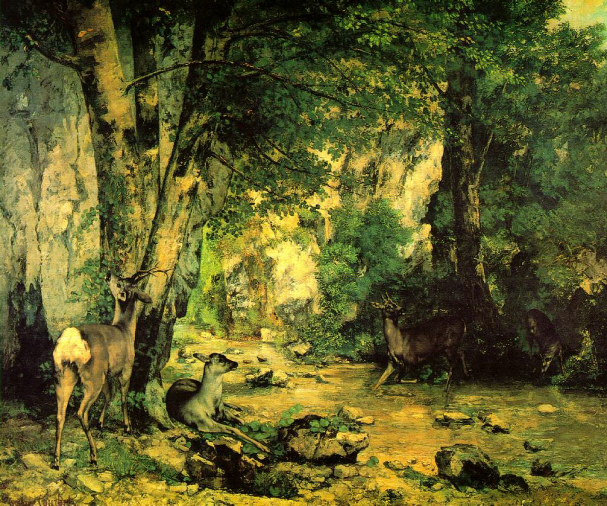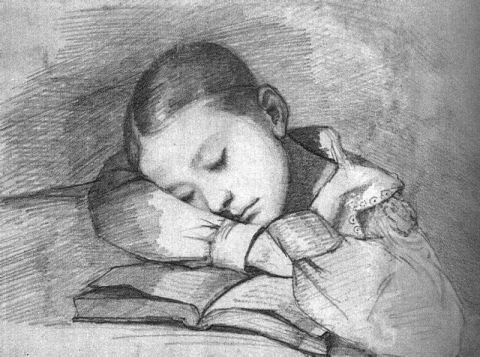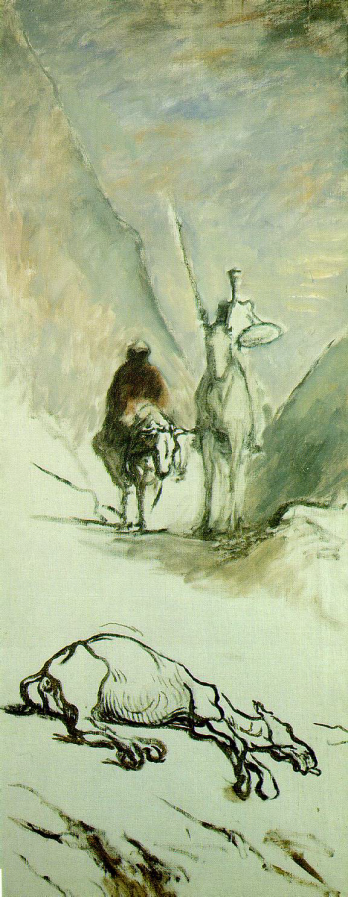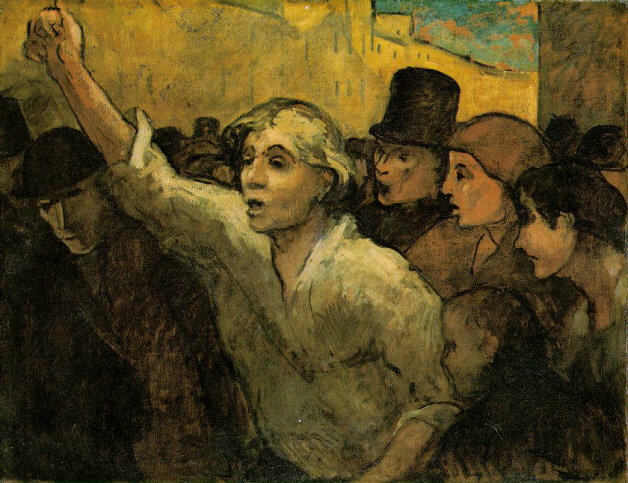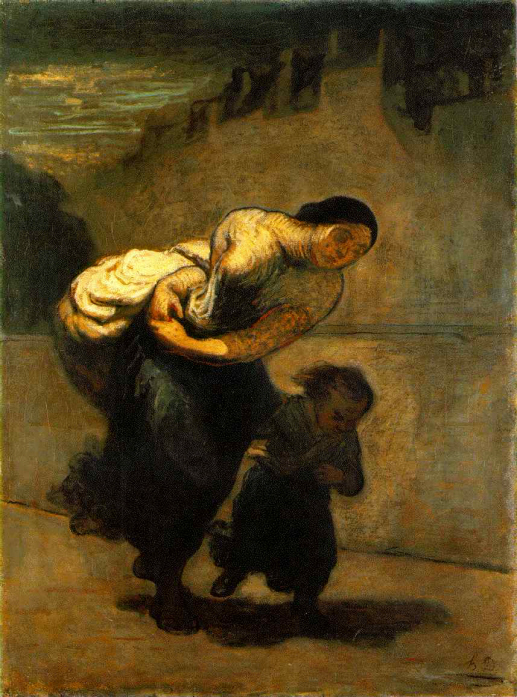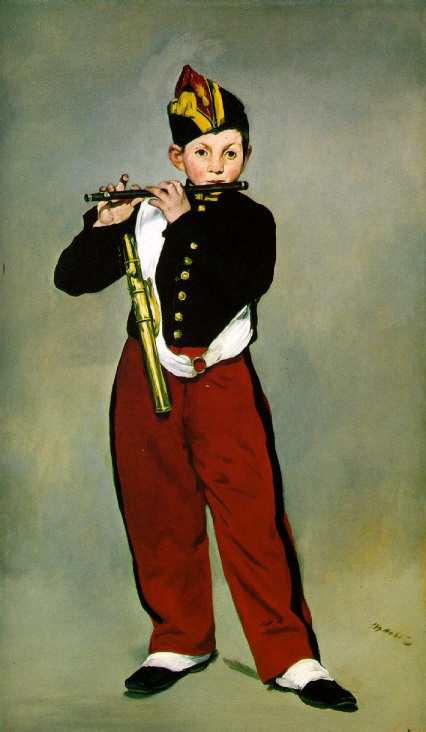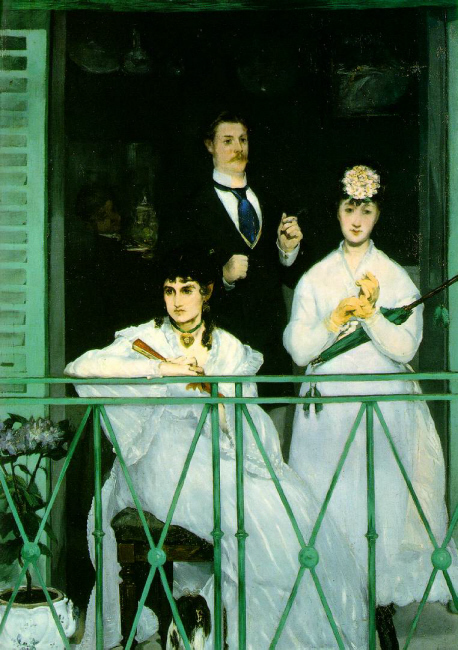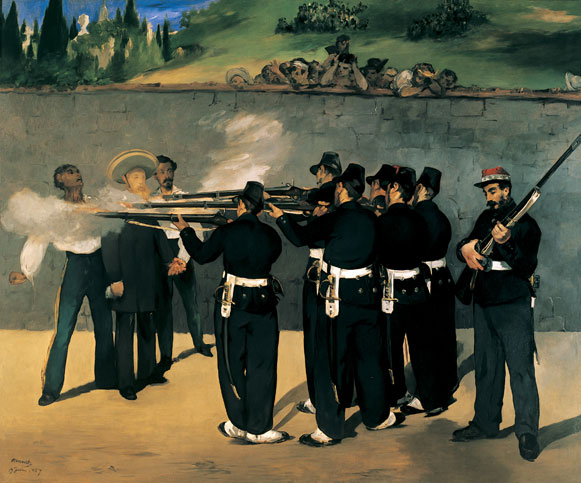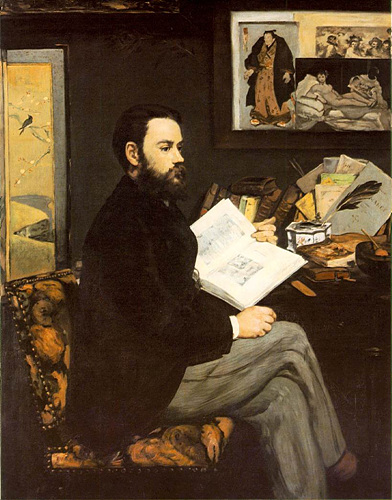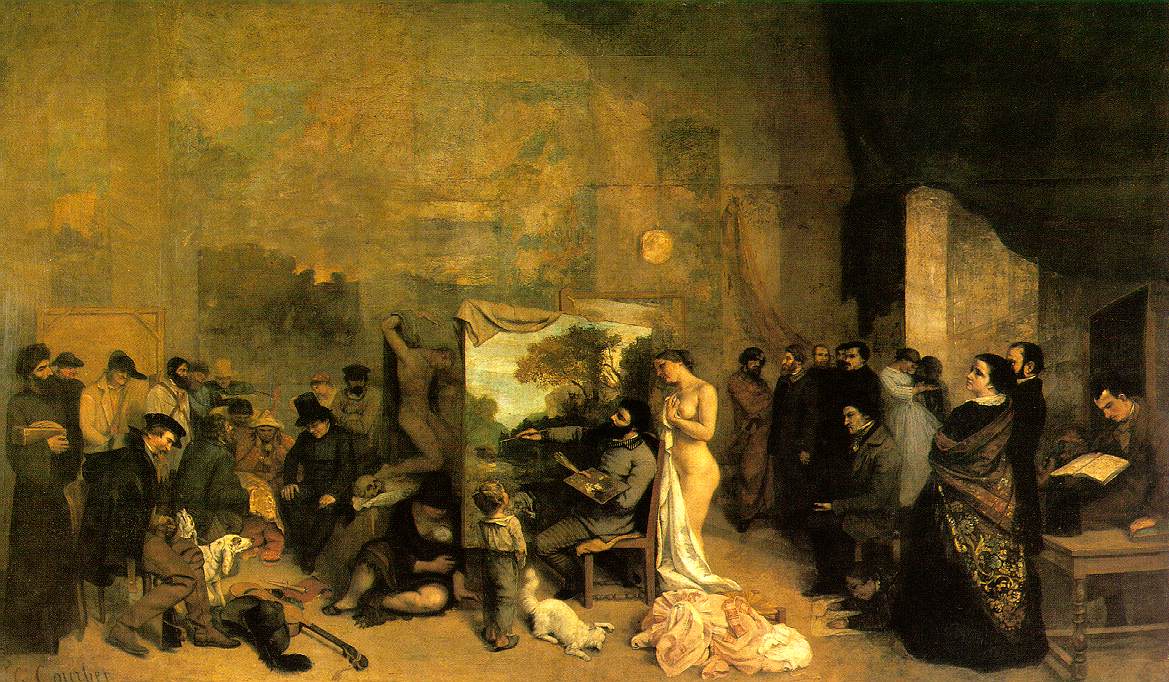
1855 (170 kB); Oil on canvas, 361 x 598 cm (11' 10 1/4" x 19' 7 1/2"); Musee d'Orsay, Paris
Courbet, Gustave (1819-77). The painter Courbet started and dominated the French movement toward realism. Art critics and the public were accustomed to pretty pictures that made life look better than it was. Courbet, against much opposition, truthfully portrayed ordinary places and people.
Gustave Courbet was born on June 10, 1819, to a prosperous farming family in Ornans, France. He went to Paris in 1841, supposedly to study law, but he soon decided to study painting and learned by copying the pictures of master artists. In 1844 his self-portrait, Courbet with a Black Dog, was accepted by the Salon, an annual public exhibition of art sponsored by the influential Royal Academy.
In 1848 a political revolution in France foreshadowed a revolution in art, as people in the arts became more open to new ideas. Courbet's early work was exhibited successfully in 1849. That same year he visited his family in the countryside and produced one of his greatest paintings, The Stone-Breakers, followed by Burial at Ornans in 1850. Both were quite unlike the romantic pictures of the day because they showed peasants in realistic settings instead of the rich in glamorized situations. In 1855 he completed a huge canvas, The Artist's Studio, and, when it was refused for an important exhibition, Courbet boldly displayed his work himself near the exhibition hall.
Courbet visited Germany in 1856, where he was welcomed by the artistic community. By 1859 he was the undisputed leader of the new generation of the French realist movement. He painted all varieties of subjects, including admirable portraits and sensuous female nudes but, most of all, scenes of nature. His series of seascapes with changing storm clouds wafting overhead begun in 1865 had a great influence on impressionist painters.
Politically a socialist, Courbet took part in some revolutionary activities for which he was imprisoned for six months in 1871. He was also fined more than he could pay, so he fled to Switzerland, where he died in the town of La Tour-de-Peilz on Dec. 31, 1877.
Daumier, Honoré (1808-79). French caricaturist, painter, and sculptor. In his lifetime he was known chiefly as a political and social satirist, but since his death recognition of his qualities as a painter has grown. In 1830, after learning the still fairly new process of lithography, he began to contribute political cartoons to the anti-government weekly Caricature. He was an ardant Republican and was sentenced to six months' imprisonment in 1832 for his attacks on Louis-Philippe, whom he represented as `Gargantua swallowing bags of gold extorted from the people'. On the suppression of political satire in 1835 he began to work for Charivari and turned to satire of social life, but at the time of the 1848 revolution he returned to political subjects. He is said to have made more than 4,000 lithographs, wishing each time that the one he had just made could be his last. In the last years of his life he was almost blind and was saved from destitution by Corot.
Daumier's paintings were probably done for the most part fairly late in his career. Although he was accepted four times by the Salon, he never exhibited his paintings otherwise and they remained practically unknown up to the time of an exhibition held at Durand-Ruel's gallery in 1878, the year of his death. The paintings are in the main a documentation of contemporary life and manners with satirical overtones, although he also did a number featuring Don Quixote as a larger-than-life hero. His technique was remarkably broad and free. As a sculptor he specialized in caricature heads and figures, and these too are in a very spontaneous style. In particular he created the memorable figure of `Ratapoil' (meaning `skinned rat'), who embodied the sinister agents of the government of Louis-Philippe. A similar political type in his graphic art was `Robert Macaire', who personified the unscrupulous profiteer and swindler.
In the directness of his vision and the lack of sentimentality with which he depicts current social life Daumier belongs to the Realist school of which Courbet was the chief representative. As a caricaturist he stands head and shoulders above all others of the 19th-century. He had the gift of expressing the whole character of a man through physiognomy, and the essence of his satire lay in his power to interpret mental folly in terms of physical absurdity. Although he never made a commercial success of his art, he was appreciated by the discriminating and numbered among his friends and admirers Delacroix, Corot, Forain, and Baudelaire. Degas was among the artists who collected his works.
Honore Daumier, a French artist, was deeply interested in people, especially the underprivileged. In Third-Class Carriage he shows us, with great compassion, a group of people on a train journey. We are especially concerned with one family group, the young mother tenderly holding her small child, the weary grandmother lost in her own thoughts, and the young boy fast asleep. The painting is done with simple power and economy of line. The hands, for example, are reduced to mere outlines but beautifully drawn. The bodies are as solid as clay, their bulk indicated by stressing the essential and avoiding the nonessential. These are not portraits of particular people but of mankind.1863-65 (150 Kb); Oil on canvas, 65.4 x 90.2 cm (25 3/4 x 35 1/2 in); The Metropolitan Museum of Art, New York
1867 (180 Kb); 132.5 x 54.5 cm, Musee d'Orsay, Paris
c. 1860 (190 Kb); Oil on canvas, 87.6 x 113 cm (34 1/2 x 44 1/2 in); The Phillips Collection, Washington, D.C.
c. 1850-53 (110 Kb); Oil on canvas, 130 x 98 cm (51 1/8 x 38 5/8 in); The Hermitage, St. Petersburg; No. 3K 1500. Formerly collection Gerstenberg/Scharf, Berlin
Honore Daumier. Gargantua. 1831. Lithography. State 2. Bibliotheque Nationale de France, Paris, France.
Manet, Edouard
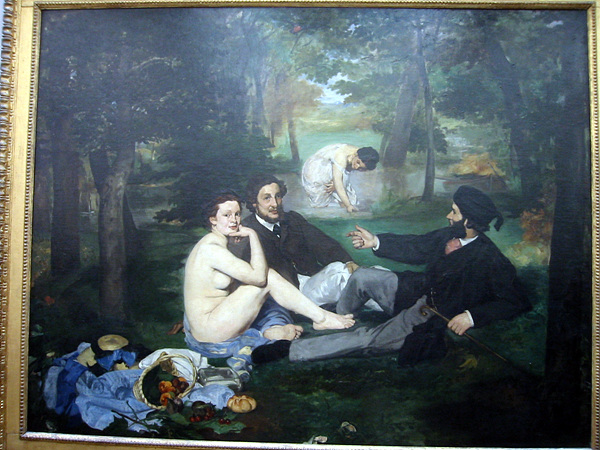
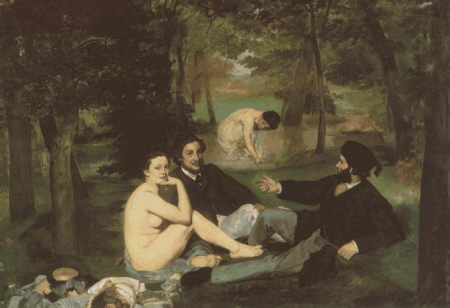
풀밭위의 식사
마네의 또하나의 시끄러운 문제작.세명이 풀밭위에 모여앉아 식사를 하고있다. 근데 이여인네가 옷을 벗고 있다는 게 문제다. 또, 이 여인의 눈빛 또한 올랭피아에서와 마찬가지로 뻔뻔하게 대중을 바라보고 있다는 점이다. 다른 두남자 역시 다른 곳에 시선을 두고 서로 조화롭지 않은 손놀림까지 모두 따로 놀고 있다는 점이 재밌는 사실이다. 이 작품은 지로르지오네의 전원의 연주와 라파엘로의 파리스의 심판을 패러디한 작품이다.
Edouard Manet. Women at the Races. 1864-1865. Oil on canvas. Cincinnati Art Museum, Cincinnati, USA.
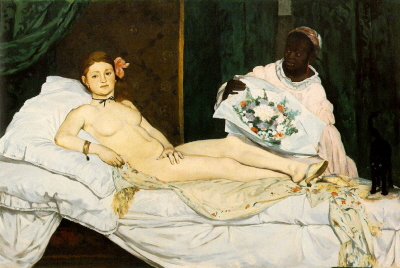
1863 (130 Kb); Oil on canvas, 130.5 x 190 cm (51 3/8 x 74 3/4 in) Musee d'Orsay, Paris
19세기 중반 오스만 시장으로 인해 파리는 빛의도시로, 물랭루즈 등장.
상류층을 상대하는 고급 매춘부가 시작되면서 누드모델 등장.
완성된 작품은 어김없이 요정이나 신화적인 이미지의 여신 모습.
이 작품에서는 그 전 누드화의 성스러움과 부끄러움을 전혀 찾아볼 수 없다.
너무나 평범하고 아름답지 않은 보통의 여인을 그려넣은 것.
그리고, 창백하리만치 하얀 피부.
평면적이게 보이는 넓은 붓터치.
전체적으로 나타나는 화이트와 블랙의 조화.
마네가 드러내고자하는 이원론적인 사고가 여기서도 유감없이 색의 대비로 이루어지고 있다.
암고양이는 프랑스 은어로 여성의 성기를 가리킨다.
올랭피아의 고객으로부터 배달된 꽃,
당시 불법매춘을 단속하는 경찰, 부르주아의 위선은 심각, 그녀가 당신을 바라보고 있는 것은
너희들의 현실을 똑바로 바라보라는 뜻.
대중, 즉 이 그림을 바라보고 있는 어떤이라도 비웃어주는 듯한 도전적인 눈빛.
마네는 거장들의 작품을 패러디 한 것으로 유명하다.
이 작품은 타치아노의 오달리스크를 패러디한 작품이다.
The Fifer. 1866. Oil on canvas. Musée d'Orsay, Paris, France
Portrait of Emile Zola. 1867-1868. Oil on canvas. Musée d'Orsay, Paris, France.마네의 작품은 당시 파리의 모습을 비난하는 그림이다.
당시 '에밀졸라' 만이 그의 작품을 호평하는 글을 써낸다, 아무조건없이...
1863년까지 낙선하여 누드화를 포기하고 <피리부는 소년>을 그렸으나 역시 낙선.
팔리지 않고 쌓여만가는 작품 들,
전통적인 부드러운 명암법 포기하고, 강하고 거친 대조를 추구하였다.
폴 뒤랑뤼엘 의 뒷받침- 인상파화가들의 작품을 사들이고, 나다르 스튜디오에서 인상파 1회. 하지만, 냉담한 반응, 뉴욕서 전시 성공.
'History of Arts > 19C' 카테고리의 다른 글
| 19 -낭만주의(터너) (1) | 2020.06.15 |
|---|---|
| 밀레 자연주의 (0) | 2020.06.15 |
| 오노레 도미에 (0) | 2020.06.15 |
| art nouveau (0) | 2020.05.11 |
| Art Nouveau (0) | 2020.05.11 |
